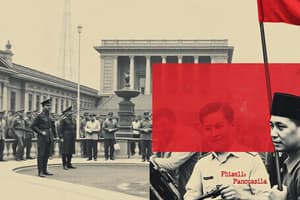Podcast
Questions and Answers
What was the primary goal of the post-proclamation rebellions in Indonesia?
What was the primary goal of the post-proclamation rebellions in Indonesia?
Which cabinet replaced the Natsir Cabinet in Indonesia?
Which cabinet replaced the Natsir Cabinet in Indonesia?
During which event did A. H. Nasution receive protection from his personal aide?
During which event did A. H. Nasution receive protection from his personal aide?
What was a significant consequence of the 30 September Movement?
What was a significant consequence of the 30 September Movement?
Signup and view all the answers
What was the main objective of the assassination of Sultan Hamengkubuwana IX?
What was the main objective of the assassination of Sultan Hamengkubuwana IX?
Signup and view all the answers
Which policy aimed to control inflation by reducing the money supply in Indonesia?
Which policy aimed to control inflation by reducing the money supply in Indonesia?
Signup and view all the answers
What characterized the party system during the Liberal Democracy era in Indonesia?
What characterized the party system during the Liberal Democracy era in Indonesia?
Signup and view all the answers
What was one notable achievement of the Ali Sastroamidjojo I Cabinet?
What was one notable achievement of the Ali Sastroamidjojo I Cabinet?
Signup and view all the answers
What was one of the key features of Guided Democracy in Indonesia?
What was one of the key features of Guided Democracy in Indonesia?
Signup and view all the answers
The anti-Chinese sentiment during the Ali Sastroamidjojo II administration was primarily fueled by what?
The anti-Chinese sentiment during the Ali Sastroamidjojo II administration was primarily fueled by what?
Signup and view all the answers
Flashcards
Post-proclamation rebellions
Post-proclamation rebellions
Rebellions that occurred after Indonesia's independence declaration, seeking to replace Pancasila with communism.
Dismissal of Prime Minister
Dismissal of Prime Minister
The removal of a prime minister due to the Renville Agreement.
Goal of Federal Pasundan
Goal of Federal Pasundan
The aim was to create a separate federal state in West Java.
Sultan Hamengkubuwana IX assassination
Sultan Hamengkubuwana IX assassination
Signup and view all the flashcards
Kartosuwirjo Rebellion
Kartosuwirjo Rebellion
Signup and view all the flashcards
A. H. Nasution's Safety
A. H. Nasution's Safety
Signup and view all the flashcards
Guided Democracy
Guided Democracy
Signup and view all the flashcards
1955 Election
1955 Election
Signup and view all the flashcards
Constituent Assembly
Constituent Assembly
Signup and view all the flashcards
Djuanda Line
Djuanda Line
Signup and view all the flashcards
Study Notes
Indonesian History Study Notes
- Post-Proclamation Rebellions: Rebellions followed Indonesia's proclamation, motivated by a desire to replace Pancasila ideology with communism.
- Minister Dismissal: Specific prime ministers were dismissed during agreements.
- Federal State Goal: The pursuit of a federal Pasundan state.
- Sultan's Assassination: Details of the assassination attempt on Sultan Hamengkubuwana IX, a key figure involved with a West Java rebellion.
- Kartoswiro's Initial Actions: The initial uprising led by Kartosuwirjo.
- Nasution's Protection: A key figure, A.H. Nasution's protection by his personal guard.
- Military Operations: Military operations in response to rebellions (DI/TII in West Java.)
- September 30th Movement: The significant impact of the September 30th Movement (G30S).
- Post-Independence Politics: Key aspects of the liberal democracy period.
- Cabinet Systems: Various Indonesian cabinets and their roles.
- Cabinet Natsir's Successes: Details of Cabinet Natsir's accomplishments.
- Cabinet Sukiman: Information about Cabinet Sukiman and the factors that eventually resulted in the end of that cabinet's tenure.
- Wilopo Cabinet: Information about the causes of the decline of the cabinet.
- Political Influence: Different political parties influencing protests.
- 1955 Elections: The significance of Indonesia's first elections.
- Constituent Assembly Task: Duties and responsibilities within the constituent assembly.
- Cabinets' Successes: Notable successes of particular Indonesian cabinets, including cabinet Ali Sastroamidjojo I.
- Asia–Africa Conference: An agreement from the Asia–Africa Conference.
- Military conflict: A specific conflict involving the Indonesian military (TNI) with a group.
- Economic Issues: Information about the early economic challenges that Indonesia faced.
- Economic Action: Actions aimed at addressing financial issues, such as reducing inflation and currency matters.
- Democracy System: Key characteristics of the democratic system in Indonesia.
- Political System Shifts: Information about the shifts from one political system to the other.
- Presidential Decree: Details regarding President Sukarno's decree.
- Reactions to Decrees: Reactions to the presidential decrees.
- Constitution Failures: Relationship between certain decrees and failures in the Indonesian constitution.
- West Papua Formation: The failure to create a West Papua state.
Studying That Suits You
Use AI to generate personalized quizzes and flashcards to suit your learning preferences.
Description
Test your knowledge on key events and figures in Indonesian history following the Proclamation of Independence. This quiz covers important uprisings, political changes, and military operations that shaped modern Indonesia. Delve into the complexities of post-independence politics and learn about significant movements like the September 30th Movement.




